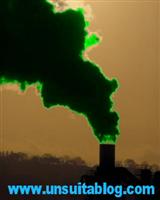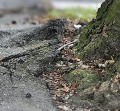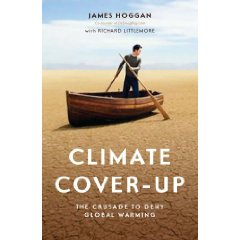Climate Cover Up: The First Extract
Posted by keith on October 9th, 2009
I’m in possession of what is already turning out to be an excellent book by Jim Hoggan and Richard Littlemore called “Climate Cover Up“. I will be publishing a review once I have finished it; which might take a little while because I have a huge stack of things to get through, but just to whet your appetite, Richard has given me permission to publish some extracts on The Unsuitablog.
Chapter Four, from which this first extract is taken, largely concerns the formation and activities of The Advancement of Sound Science Coalition (TASSC), a monstrous “Astroturf” which was created on the suggestion of the public relations company APCO (the same company that fought to promote tobacco in the face of virtually all medical advice). It also discusses at length the Astroturfing activities of The American Petroleum Institute (API). This section introduces a veteran of the anti-climate change lobby, Frederick Seitz, but most importantly “Mr Junk Science”, Steven Milloy. Enjoy.
TASSC’s early membership list included “sound science” supporters like Amoco, Exxon, Occidental Petroleum, Santa Fe Pacific Gold Corporation, Procter & Gamble, the Louisiana Chemical Association, the National Pest Control Association, General Motors, 3m, Chevron, and Dow Chemical. For “science advisors,” they had people such as Frederick Seitz.
In the 1960s and ‘70s, Seitz was a widely admired scientist, a former president of both the National Academy of Sciences and Rockefeller University. In 1978 he took that reputation to work for the R.J. Reynolds Tobacco Company. According to “While Washington Slept,” a May 2006 Vanity Fair article by investigative journalist Mark Hertsgaard, over a ten-year period Seitz was responsible for handing out US$45 million in tobacco money to people who were pursuing research that overwhelmingly failed to link tobacco to anything the least bit negative. Seitz later admitted to accepting almost US$900,000 of that money himself.
But by the late 1980s he seemed to have lost a step. In a Philip Morris interoffice memo dated 1989, an executive named Alexander Holtzman reported that he was told that “Dr. Seitz is quite elderly and not sufficiently rational as to offer advice.” Yet Seitz continued to stand as a TASSC regular, in particular lending his name and leveraging his old National Academy of Sciences affiliation to the global warming denial movement for nineteen more years, dying in 2008 at the age of ninety-six.
It’s probably time to introduce Steven Milloy, a.k.a. “The Junkman,” to our cast of characters. While tassc was originally run by executive director Garrey Carruthers, an economist and former New Mexico governor, Steven Milloy took over in 1997. Milloy’s academic background is also considerable: he has an undergraduate degree in science from Johns Hopkins, a masters in health sciences and biostatistics (also from Johns Hopkins), and a masters in law from Georgetown. But there is no record of his directly pursuing science or law as a career.
Instead, Milloy emerged in the 1990s working for a series of public relations and lobby firms, including the eop Group, which the Web site pr Watch.org describes as “a well-connected, Washington-based lobby firm whose clients have included the American Crop Protection Association (the chief trade association of the pesticide industry), the American Petroleum Institute, AT&T, the Business Roundtable, the Chlorine Chemistry Council, Dow Chemical Company, Edison Electric Institute (nuclear power), Fort Howard Corp. (a paper manufacturer), International Food Additives Council, Monsanto Co., National Mining Association, and the Nuclear Energy Institute.”
Milloy, who is currently an “adjunct scholar” at the Competitive Enterprise Institute and formerly held that position at the Cato Institute, is also the creator and proprietor of the Web site JunkScience.com, which works to “debunk” everything from the dangers of secondhand smoke to the risks of genetically modified foods. Milloy was a founding member of a team assembled by the American Petroleum Institute (API) to create a 1998 “Global Climate Science Communication Action Plan” (the precise contents of which Greenpeace later discovered and made available for public viewing). The api made no bones about its intent in creating its plan for the public. The document plainly states that its purpose is to convince the public, through the media, that climate science is awash in uncertainty. Notwithstanding that the industry’s own scientists were saying as early as 1995 that the science of climate change was undeniable(as in the New York Times report discussed in Chapter 1), the API set out an entire strategy bent on making doubt, in the words of the memo below, “conventional wisdom.” The API document begins with a kind of mission statement (the parenthetical additions appear as in the original):
Victory Will Be Achieved When
• Average citizens “understand” (recognize) uncertainties in climate science; recognition of uncertainties becomes part of the “conventional wisdom”
• Media “understands” (recognizes) uncertainties in climate science
• Media coverage reflects balance on climate science and recognition of the validity of viewpoints that challenge the current “conventional wisdom”
• Industry senior leadership understands uncertainties in climate science, making them stronger ambassadors to those who shape climate policy
• Those promoting the Kyoto treaty on the basis of extant science appear to be out of touch with reality.
The statement seems to make clear that the goal was not to promote an understanding of science, but to spread uncertainty. The goal was not to put the best case before a deserving public, but to ensure at all times that the public was treated to “balance”—and in this case, the API strategists meant that every time a top scientist offered the public new insights into the risks of climate change, the institute would be there with a contradictory view. Victory would be achieved when the public accepted this balance—this confusion—as “conventional wisdom.” It was also a priority that industry leaders learn not about science but about uncertainty, with a specific goal of attacking the Kyoto agreement, making its supporters appear “out of touch with reality.” There is, however, no contention here that Kyoto supporters really were out of touch, only that the api would like to cast them as such.
The plan went on to describe how the api might achieve these goals, beginning with a campaign to search out and recruit “new (scientific) faces who will add their voices to those recognized scientists who already are vocal.” The document goes on to expand on the list of specific tactics (with my emphasis added in italics):
• Develop a global climate science information kit for media including peer-reviewed papers that undercut the “conventional wisdom” on climate science. This kit also will include understandable communications, including simple fact sheets that present scientific uncertainties in language that the media and public can understand.
• Conduct briefings by media-trained scientists for science writers in the top 20 media markets, using the information kits. Distribute the information kits to daily newspapers nationwide with offer of scientists to brief reporters at each paper. Develop, disseminate radio news releases featuring scientists nationwide, and offer scientists to appear on radio talk shows across the country.
• Produce, distribute a steady stream of climate science information via facsimile and e-mail to science writers around the country.
• Produce, distribute via syndicate and directly to newspapers nationwide a steady stream of op-ed columns and letters to the editor authored by scientists.
• Convince one of the major news national tv journalists (e.g., John Stossel) to produce a report examining the scientific underpinnings of the Kyoto treaty.
• Organize, promote and conduct through grassroots organizations a series of campus/community workshops/debates on climate science in 10 most important states during the period mid-August through October, 1998.
• Consider advertising the scientific uncertainties in select markets to support national, regional and local (e.g. workshops / debates), as appropriate.
Like the Western Fuels Association campaign in the early 1990s and the TASSC campaign that followed, this document once again set out a major work plan that involved burying science writers in “a steady stream of climate science information” concentrating not on quality but on doubt. It can hardly be a coincidence that even as the science itself was becoming ever more certain—and ever more alarming—the “conventional wisdom” in the late 1990s and into the early part of this century turned more and more to confusion and doubt.
More to come, but if that hasn’t already made you angry then I’d be very surprised indeed.





